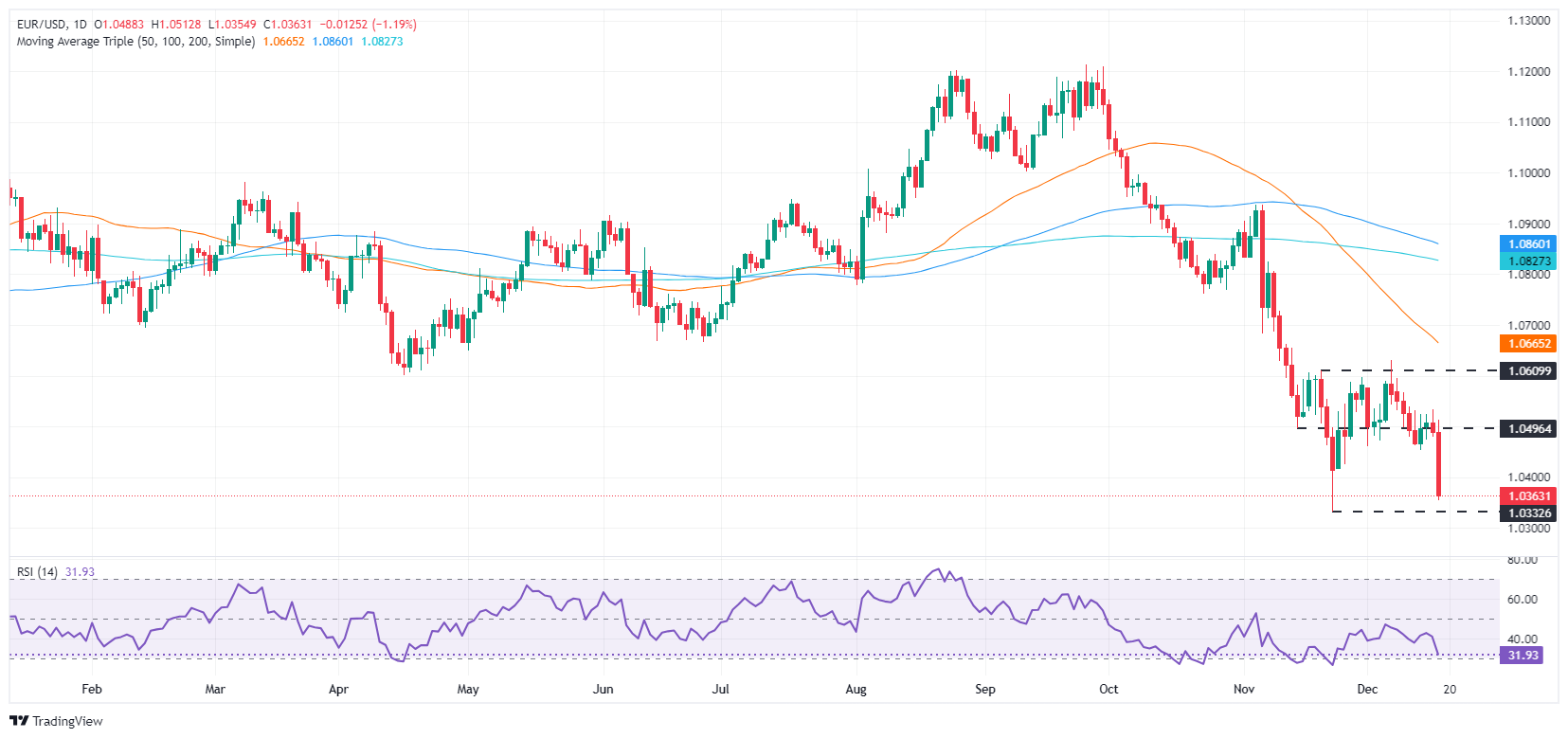EUR/USD collapses below 1.0400 as Fed eyes two cuts in 2025
- EUR/USD experiences sharp decline in response to the Federal Reserve's 25 basis point rate cut paired with a cautious outlook on future policy adjustments.
- Fed Chair Jerome Powell emphasizes a careful approach to further rate changes, noting persistent inflation risks, stable labor market.
- Fed's updated economic projections indicate only modest rate reductions in the coming years, setting the federal funds rate target at 3.4% by 2026.
The EUR/USD sank sharply after the Fed cut interest rates but also adopted a slightly hawkish stance, as the central bank estimates 100 basis points of easing toward the next two years. At the time of writing, the pair trades below 1.0400, volatile.
EUR/USD pair tumbles below 1.0400 as Fed Chair Jerome Powell speaks
In his press conference, Powell said that the central bank could be more cautious about considering additional adjustments, acknowledging that the policy is less restrictive. He added that risks and uncertainty around inflation are skewed to the upside and added that higher inflation is one of the reasons for the adjustment to the dot plot.
Jerome Powell added that it could take a year or two for inflation to get to the 2% goal, adding that the labor market is not cooling in a way that raises concerns.
The Federal Reserve cut rates by 25 basis points to the 4.25%-4.50% range, yet the decision was not unanimous, as Cleveland Fed President Beth Hammack voted to keep rates unchanged.
The statement changed little from the last meeting, though traders were focused on the Summary of Economic Projections (SEP).
The central bank's monetary policy statement revealed that economic activity continued to expand solidly and acknowledged the labor market conditions had eased. Despite the improvement in employment, Fed policymakers decided to keep the language of “The Committee judges that the risks to achieving its employment and inflation goals are roughly in balance.”
Meanwhile, the SEP showed that officials penciled just two rate cuts in 2025 and 2026, driving the fed funds rate to 3.4% in 24 months.
EUR/USD Reaction to Fed's Chair Powell press conference
The EUR/USD has plunged sharply, clearing the 1.0450 psychological level, extending its losses toward the day's lows at 1.0410. The pair would remain trading volatile, as Fed Chair Powell takes the stand. Immediate resistance is seen at the December 13 low of 1.0452, and support at 1.0400. If cleared, the next support would be the YTD low of 1.0331.
Euro FAQs
The Euro is the currency for the 19 European Union countries that belong to the Eurozone. It is the second most heavily traded currency in the world behind the US Dollar. In 2022, it accounted for 31% of all foreign exchange transactions, with an average daily turnover of over $2.2 trillion a day. EUR/USD is the most heavily traded currency pair in the world, accounting for an estimated 30% off all transactions, followed by EUR/JPY (4%), EUR/GBP (3%) and EUR/AUD (2%).
The European Central Bank (ECB) in Frankfurt, Germany, is the reserve bank for the Eurozone. The ECB sets interest rates and manages monetary policy. The ECB’s primary mandate is to maintain price stability, which means either controlling inflation or stimulating growth. Its primary tool is the raising or lowering of interest rates. Relatively high interest rates – or the expectation of higher rates – will usually benefit the Euro and vice versa. The ECB Governing Council makes monetary policy decisions at meetings held eight times a year. Decisions are made by heads of the Eurozone national banks and six permanent members, including the President of the ECB, Christine Lagarde.
Eurozone inflation data, measured by the Harmonized Index of Consumer Prices (HICP), is an important econometric for the Euro. If inflation rises more than expected, especially if above the ECB’s 2% target, it obliges the ECB to raise interest rates to bring it back under control. Relatively high interest rates compared to its counterparts will usually benefit the Euro, as it makes the region more attractive as a place for global investors to park their money.
Data releases gauge the health of the economy and can impact on the Euro. Indicators such as GDP, Manufacturing and Services PMIs, employment, and consumer sentiment surveys can all influence the direction of the single currency. A strong economy is good for the Euro. Not only does it attract more foreign investment but it may encourage the ECB to put up interest rates, which will directly strengthen the Euro. Otherwise, if economic data is weak, the Euro is likely to fall. Economic data for the four largest economies in the euro area (Germany, France, Italy and Spain) are especially significant, as they account for 75% of the Eurozone’s economy.
Another significant data release for the Euro is the Trade Balance. This indicator measures the difference between what a country earns from its exports and what it spends on imports over a given period. If a country produces highly sought after exports then its currency will gain in value purely from the extra demand created from foreign buyers seeking to purchase these goods. Therefore, a positive net Trade Balance strengthens a currency and vice versa for a negative balance.



